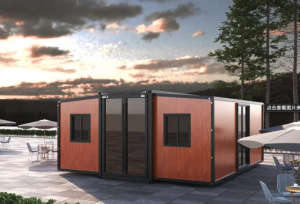From Design to Delivery: One-Stop Analysis of Prefabricated House Construction Process and Advantages
In the fast-paced modern life, people's demand for living space is no longer limited to the basic function of sheltering from the wind and rain, but also seeks for efficient, environmentally friendly and personalized living experience. Prefabricated houses, as an innovative technology in the field of construction, are gradually becoming the new favorite of modern living style with its unique construction process and significant advantages.
In this article, we will analyze the construction process of prefabricated houses from the whole process of design, production, transportation to delivery, and discuss the multiple advantages it brings.

Design phase: the perfect blend of personalization and standardization
The design of a prefabricated house is the starting point of the entire construction process, which combines the essence of personalization and standardization. Designers make use of advanced CAD (Computer Aided Design) software and BIM (Building Information Modeling) technology to carry out accurate 3D modeling and optimization of the scheme according to the customer's needs and the characteristics of the plot.
This process not only ensures that the exterior design of the house meets aesthetic requirements, but more importantly, the modular design divides the house into multiple prefabricated components, facilitating subsequent production and assembly. The combination of personalization and standardization not only meets the diversified needs of customers, but also improves construction efficiency.
Production stage: factory production with quality control
Unlike traditional on-site pouring, most of the components of prefabricated houses are produced in factories. These components, including walls, floor slabs, roofs, etc., are made of high-quality building materials and undergo precision machining and strict quality control to ensure the dimensional accuracy and stable performance of each product.
Factory production not only reduces the complexity and uncertainty of on-site construction, but also greatly shortens the construction cycle. At the same time, due to the controlled production environment, it effectively reduces noise, dust and other pollution during the construction process, which is in line with the requirements of green building.
Transportation Phase: Efficient Logistics, Reduced Site Interference
The completed prefabricated components are transported to the construction site by professional transportation equipment. The precise size and weight of the components, as well as the use of standardized packaging, make the transportation process more efficient and safer. In addition, the prefabricated components are usually transported during off-peak hours to minimize disruptions to the neighborhood and traffic.
This “building block” type of construction makes the construction site more tidy and organized, reducing the clutter and disorder common to traditional construction sites.
Delivery Stage: Fast Assembly, Ready to Live
At the construction site, a professional installation team uses cranes to hoist the prefabricated components into place for precise splicing and fixing. As the connections between the components are mostly standardized, the installation process is both fast and accurate. Compared to traditional construction methods, prefabricated houses can be built in 30% to 50% shorter cycles, greatly accelerating project delivery.
At the same time, since most of the work is done in the factory, on-site wet work is reduced, which is conducive to construction quality control and project quality improvement. The delivered prefabricated houses are not only structurally stable and have superior thermal insulation performance, but can also be internally decorated according to personal preferences, realizing true buy-now-live-in.
Summary of Advantages
In summary, the whole process of prefabricated houses from design to delivery shows its unique construction process and significant advantages. The combination of personalized customization and standardized production meets the diversified needs of customers; factory production improves construction efficiency and quality control; efficient logistics reduces on-site interferences; and fast assembly realizes the convenient experience of buy-and-live.
In addition, prefabricated houses also have the advantages of energy saving and environmental protection, strong seismic performance, etc., which is an important development direction for future living style. With the continuous progress of technology and growing market demand, prefabricated houses will surely occupy a more important position in the construction field.
Post time: 09-12-2024







